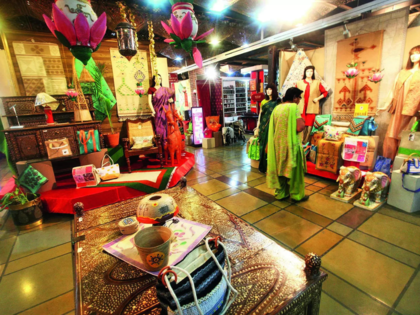
Now that there are crafts aplenty available both online and in stores, heading to a government-owned emporium was perhaps naive. Who goes there these days anyway? Only people of my generation or older, presumably, for whom these were once the only places to access India's amazing traditional art and crafts. The paucity of stores selling crafts in the bad old days of socialism made state emporia the only option for traditional weaves, homeware, and even gifts.
Some of them were better than others, of course. During my college days, we were fans of mirrorwork kurtas and shawls from Gurjari; the best Chanderi and Maheshwari sarees were from Mrignayani (Madhya Pradesh), Utkalika was a favourite haunt not only for its Sambalpuri ikat sarees but also for patachitra paintings, Lepakshi for Pochampalli and pearls, Poompuhar for wooden Ganeshas and Tanjore plates, Phulkari for, well, phulkari....
By then - the 1980s - NGOs had begun to tempt us too with good quality, better-designed crafts, like Dastkar, Urmul, Sewa Gujarat and Sewa Lucknow, and Dilli Haat. But that was no reason for the emporia to sit back and do nothing. They should have pivoted towards showcasing less-known crafts that need state support to survive. Instead, bureaucratic inertia took over, leading to mindless merchandising; and they are still stocking the same old stuff.
Their excuse, presumably, is the continuing inflow of foreign tourists to those state-owned stores, ferried there by tour operators. In the bargain these emporia have totally lost their discerning Indian clientele who appreciate art and craft and still want to buy traditionally handmade items. No longer can any sort of junk be dished out in the name of craft as these days Indian buyers are even better informed than before and have more craft purveyors to choose from.
Even a cursory look at the list of Shilp Guru and Sant Kabir awards not to mention the Padmas every year reveals the mind-boggling array of crafts we have in India and the incredible skills of our craftspeople, from weaving to woodwork, pottery to block-printing, basketry to embroidery, painting to jewellery, leathercraft to stone carving and more. What traditional crafts often lack is relevance to contemporary life; but that is now easily remedied by design inputs.
And NGOs are doing precisely that, successfully marketing crafts to a new generation of Indians. The fastest-growing segment is modernised craft: minimalist Naga cushion covers to black Longpi espresso cups. Another sector is traditional craft honed to astonishing excellence, returning to age-old techniques. These come at a price, but genuine lovers of craft are willing to pay for it, from vegetable dyed Patan double ikat patolas to exquisite meenakari and more.
The few good things still left in state emporia also languish because of lack of marketing. New generations of buyers do not know what they have.
The West Bengal emporium actually effected a miraculous turnaround when it changed its name - from Manjusha to Biswa Bangla - as well as its attitude, not only improving the selection of crafts but also marketing them imaginatively. It has even revived some flagging weaving traditions, such as Baluchari sarees and muslin yardage. It has become what Gurjari used to be back in the 1980s: trendy and attuned to the market. If Bengal can do it, so can the others.
But if state-owned emporia do not improve the choice and quality of their merchandise fast, there is no reason for them to continue, desultorily occupying valuable real estate. They are, in fact, doing Indian crafts a disservice by stocking tacky, often badly made product.
(Catch all the Business News, Breaking News, Budget 2024 Events and Latest News Updates on The Economic Times.)
Subscribe to The Economic Times Prime and read the ET ePaper online.
Read More News on
(Catch all the Business News, Breaking News, Budget 2024 Events and Latest News Updates on The Economic Times.)
Subscribe to The Economic Times Prime and read the ET ePaper online.










 Get Unlimited Access to The Economic Times
Get Unlimited Access to The Economic Times
